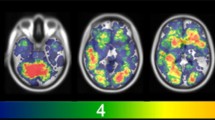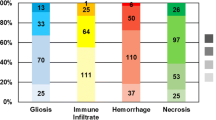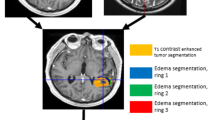Abstract
Purpose
Brain metastases (BM) remain a significant cause of morbidity and mortality in breast cancer (BC) patients. Specific factors promoting the process of BM and predilection for selected neuro-anatomical regions remain unknown, yet may have major implications for prevention or treatment. Anatomical spatial distributions of BM from BC suggest a predominance of metastases in the hindbrain and cerebellum. Systematic approaches to quantifying BM location or location-based analyses based on molecular subtypes, however, remain largely unavailable.
Methods
We analyzed stereotactic Cartesian coordinates derived from 134 patients undergoing gamma- knife radiosurgery (GKRS) for treatment of 407 breast cancer BMs to quantitatively study BM spatial distribution along principal component axes and by intrinsic molecular subtype (ER, PR, Herceptin). We used kernel density estimators (KDE) to highlight clustering and distribution regions in the brain, and we used the metric of mutual information (MI) to tease out subtle differences in the BM distributions associated with different molecular subtypes of BC. BM location maps according to vascular and anatomical distributions using Cartesian coordinates to aid in systematic classification of tumor locations were additionally developed.
Results
We corroborated that BC BMs show a consistent propensity to arise posteriorly and caudally, and that Her2+ tumors are relatively more likely to arise medially rather than laterally. To compare the distributions among varying BC molecular subtypes, the mutual information metric reveal that the ER−PR−Her2+ and ER−PR−Her2− subtypes show the smallest amount of mutual information and are most molecularly distinct. The kernel density contour plots show a propensity for triple negative BC to arise in more superiorly or cranially situated BMs.
Conclusions
We present a novel and shareable workflow for characterizing and comparing spatial distributions of BM which may aid in identifying therapeutic or diagnostic targets and interactions with the tumor microenvironment. Further characterization of these patterns with larger multi-institutional data-sets may have major impacts on treatment or management of cancer patients.






Similar content being viewed by others
References
Cardinal T et al (2022) Anatomical and topographical variations in the distribution of brain metastases based on primary cancer origin and molecular subtypes: a systematic review. Neuro-Oncol Adv 4(1):vdab170
Schroeder T et al (2020) Mapping distribution of brain metastases: does the primary tumor matter? J Neurooncol 147(1):229–235
Quattrocchi CC et al (2012) Spatial brain distribution of intra-axial metastatic lesions in breast and lung cancer patients. J Neurooncol 110(1):79–87
Neman J et al (2021) Use of predictive spatial modeling to reveal that primary cancers have distinct central nervous system topography patterns of brain metastasis. J Neurosurg 1:1–9
Fidler IJ et al (2002) The seed and soil hypothesis: vascularisation and brain metastases. Lancet Oncol 3(1):53–57
Ma J et al (2021) Macrophages/microglia in the glioblastoma tumor microenvironment. Int J Mol Sci 22(11):5775
Liu Q et al (2017) Factors involved in cancer metastasis: a better understanding to “seed and soil’’ hypothesis. Mol Cancer 16(1):1–19
Choy C et al (2017) Cooperation of neurotrophin receptor trkb and her2 in breast cancer cells facilitates brain metastases. Breast Cancer Res 19(1):1–11
Priego N et al (2018) Author correction: stat3 labels a subpopulation of reactive astrocytes required for brain metastasis. Nat Med 24(9):1481
Zhang L et al (2015) Microenvironment-induced pten loss by exosomal microrna primes brain metastasis outgrowth. Nature 527(7576):100–104
Gagliardi F et al (2021) Role of stereotactic radiosurgery for the treatment of brain metastasis in the era of immunotherapy: a systematic review on current evidences and predicting factors. Crit Rev Oncol Hematol 165:103431
Fuentes R et al (2018) Surgery versus stereotactic radiotherapy for people with single or solitary brain metastasis. Cochrane Database Syst Rev 8
Cover T, Thomas J (2006) Joint entropy and conditional entropy. Elements of Information Theory, 2nd edn. Wiley, Hoboken, p 16
Kirby M (2001) Geometric data analysis: an empirical approach to dimensionality reduction and the study of patterns, vol 31. Wiley, New York
Pedregosa F et al (2011) Scikit-learn: machine learning in python. J Mach Learn Res 12:2825–2830
Khan S et al (2007) Relative performance of mutual information estimation methods for quantifying the dependence among short and noisy data. Phys Rev E 76(2):026209
Steuer R et al (2002) The mutual information: detecting and evaluating dependencies between variables. Bioinformatics 18(suppl 2):S231–S240
Scott DW (2015) Multivariate density estimation: theory, practice, and visualization. Wiley, New York
Efron B (2000) The bootstrap and modern statistics. J Am Stat Assoc 95(452):1293–1296
Remsik J et al (2022) Leptomeningeal metastatic cells adopt two phenotypic states. Cancer Rep 5(4):e1236
Martirosian V et al (2021) Medulloblastoma uses gaba transaminase to survive in the cerebrospinal fluid microenvironment and promote leptomeningeal dissemination. Cell Rep 35(13):109302
Quattrocchi CC et al (2013) Brain metastatic volume and white matter lesions in advanced cancer patients. J Neurooncol 113(3):451–458
Hengel K et al (2013) Attributes of brain metastases from breast and lung cancer. Int J Clin Oncol 18(3):396–401
Brandner S (2021) Molecular diagnostics of adult gliomas in neuropathological practice. Acta Med Acad 50(1):29–46
Huang X et al (2010) Transventricular delivery of sonic hedgehog is essential to cerebellar ventricular zone development. Proc Natl Acad Sci 107(18):8422–8427
Memi F et al (2018) Multiple roles of sonic hedgehog in the developing human cortex are suggested by its widespread distribution. Brain Struct Funct 223(5):2361–2375
Kyeong S et al (2017) Subtypes of breast cancer show different spatial distributions of brain metastases. PLoS ONE 12(11):e0188542
Izutsu N et al (2021) Cerebellar preference of luminal a and b type and basal ganglial preference of her2-positive type breast cancer-derived brain metastases. Mol Clin Oncol 15(3):1–7
Ismael SAA et al (2020) An enhanced deep learning approach for brain cancer MRI images classification using residual networks. Artif Intell Med 102:101779
Carter GC et al (2021) Prognostic factors in hormone receptor-positive/human epidermal growth factor receptor 2-negative (hr+/her2-) advanced breast cancer: a systematic literature review. Cancer Manag Res 13:6537
Neman J et al (2014) Human breast cancer metastases to the brain display gabaergic properties in the neural niche. Proc Natl Acad Sci 111(3):984–989
Acknowledgements
Partial funding through the USC Norris Comprehensive Cancer Center’s Multi-Level Cancer Risk Prediction Models pilot Project Award, ’Molecular, Clinical and Neuro-imaging Determinants of Spatiotemporal Pathogenesis of Cancer-Specific Brain Metastases: Data Analysis and Longitudinal Modeling’ (12/01/2020-11/30/2021) is gratefully acknowledged.
Funding
Funding was provided by National Institutes of Health (Grant no. USC Norris Comprehensive Cancer Center Pilot Award).
Author information
Authors and Affiliations
Corresponding author
Ethics declarations
Conflict of interest
The authors have no conflicts of interest to disclose.
Additional information
Publisher's Note
Springer Nature remains neutral with regard to jurisdictional claims in published maps and institutional affiliations
Supplementary Information
Below is the link to the electronic supplementary material.
Rights and permissions
Springer Nature or its licensor holds exclusive rights to this article under a publishing agreement with the author(s) or other rightsholder(s); author self-archiving of the accepted manuscript version of this article is solely governed by the terms of such publishing agreement and applicable law.
About this article
Cite this article
Mahmoodifar, S., Pangal, D.J., Cardinal, T. et al. A quantitative characterization of the spatial distribution of brain metastases from breast cancer and respective molecular subtypes. J Neurooncol 160, 241–251 (2022). https://doi.org/10.1007/s11060-022-04147-9
Received:
Accepted:
Published:
Issue Date:
DOI: https://doi.org/10.1007/s11060-022-04147-9




